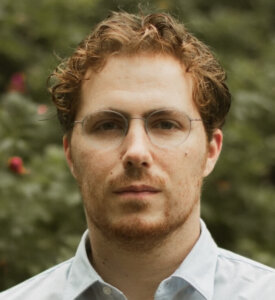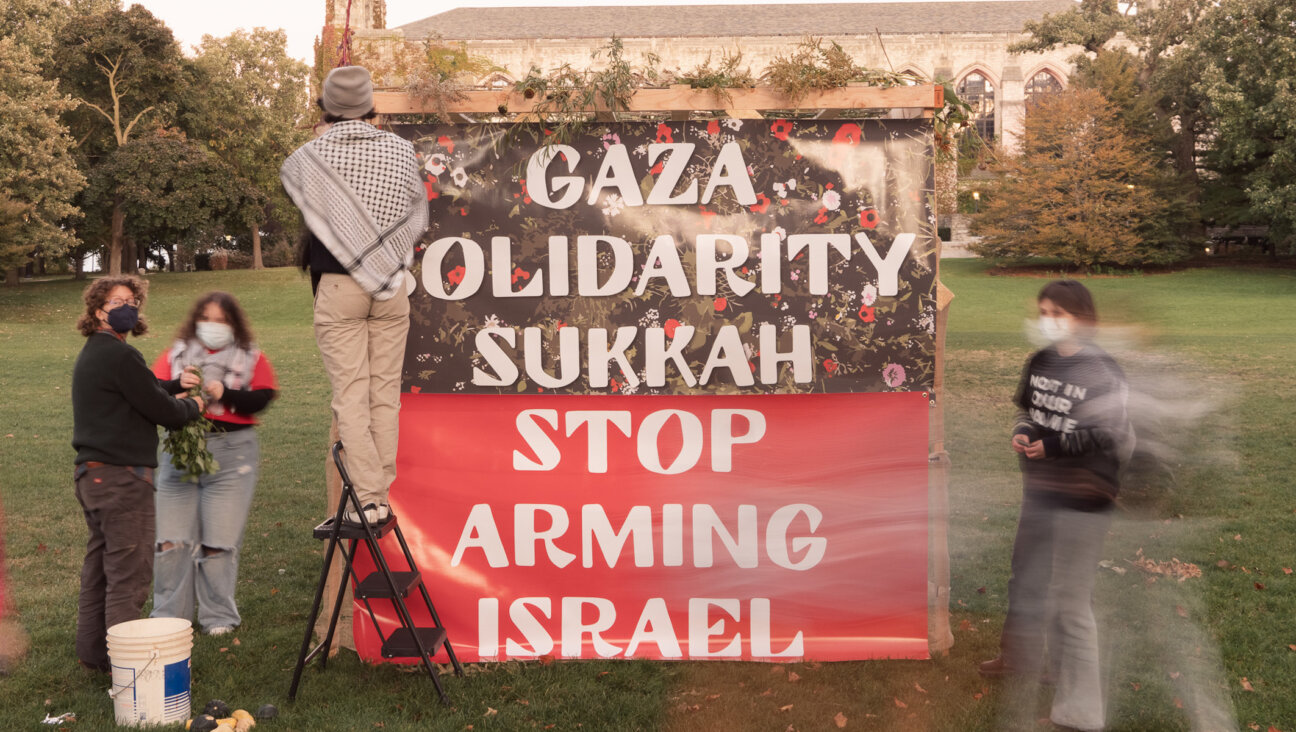Special ReportAmerican Jews asked to pick sides in wrenching debate over how to rebuild kibbutz hit hardest on Oct. 7
Nir Oz survivors, split over where to resettle, are caught between a dysfunctional Israeli government and wary American philanthropists
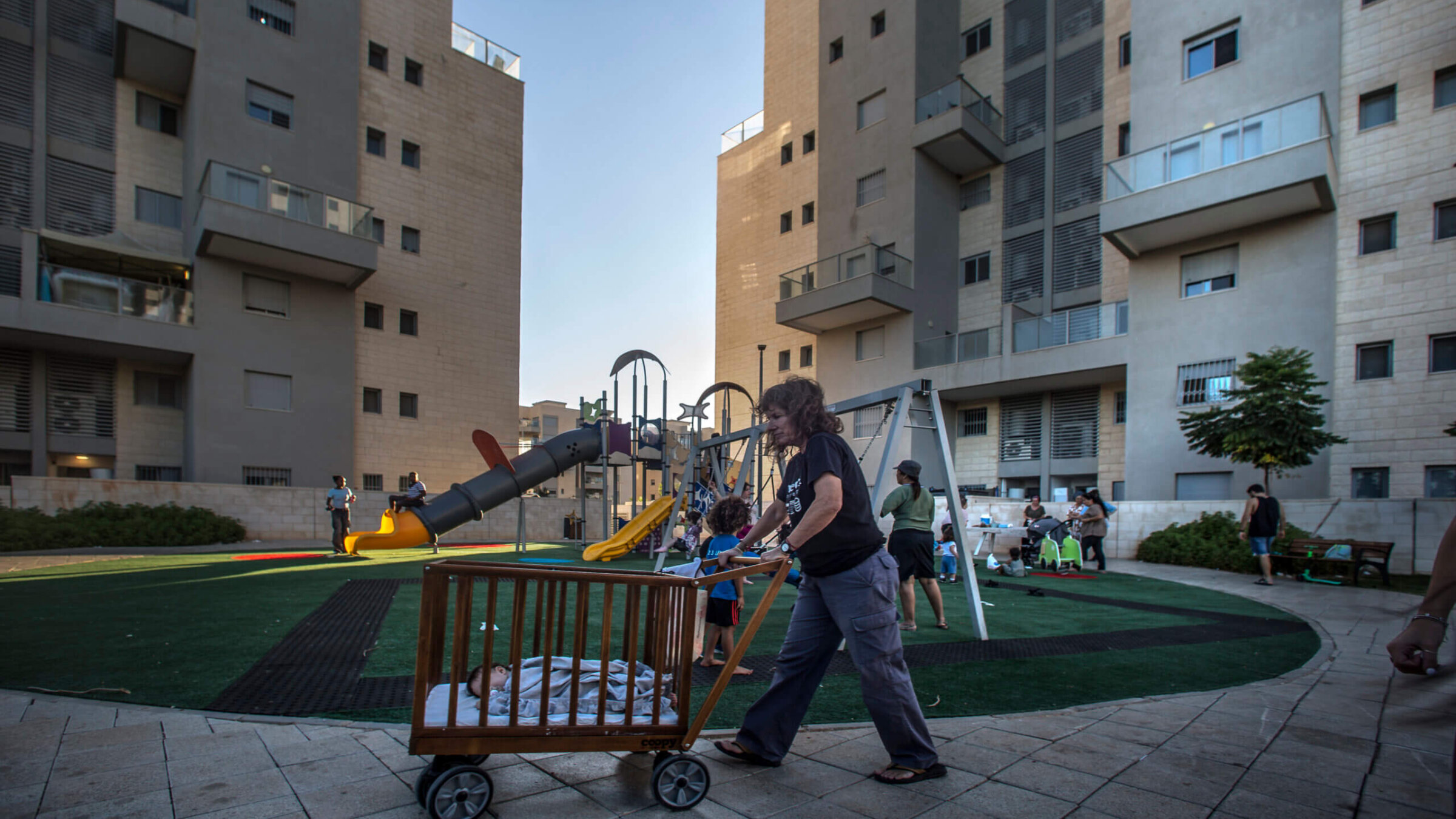
Neomit Dekel-Chen, who escaped her captors on Oct. 7 and whose son is still being held in Gaza, at a community picnic in Kiryat Gat, where the displaced residents of Kibbutz Nir Or are living. Photo by Rina Castelnuovo for the Forward
To report this article, Arno Rosenfeld spent two weeks in Israel, visiting Kibbutz Nir Oz, Kibbutz Beit Nir and Kiryat Gat.
BEIT NIR, Israel — When Chen Itzik was 10 years old, his parents divorced and his mother moved him from Kibbutz Nir Oz, on the Gaza border, to Ashdod, an industrial port city an hour north. A year later, he insisted on returning to the kibbutz. With his father away in nursing school, Itzik recalled raising himself, sleeping in the communal children’s house and going to work afternoons in the potato fields after school.
“You cannot leave a kibbutz,” he explained when we met here a few weeks ago.
On Oct. 7, Itzik and his wife hustled their three children into a bomb shelter on Nir Oz, slamming shut a lock he’d installed six years earlier. That lock may have saved his family, as some 200 terrorists rampaged through the community, killing or kidnapping more than a quarter of its 400 residents.
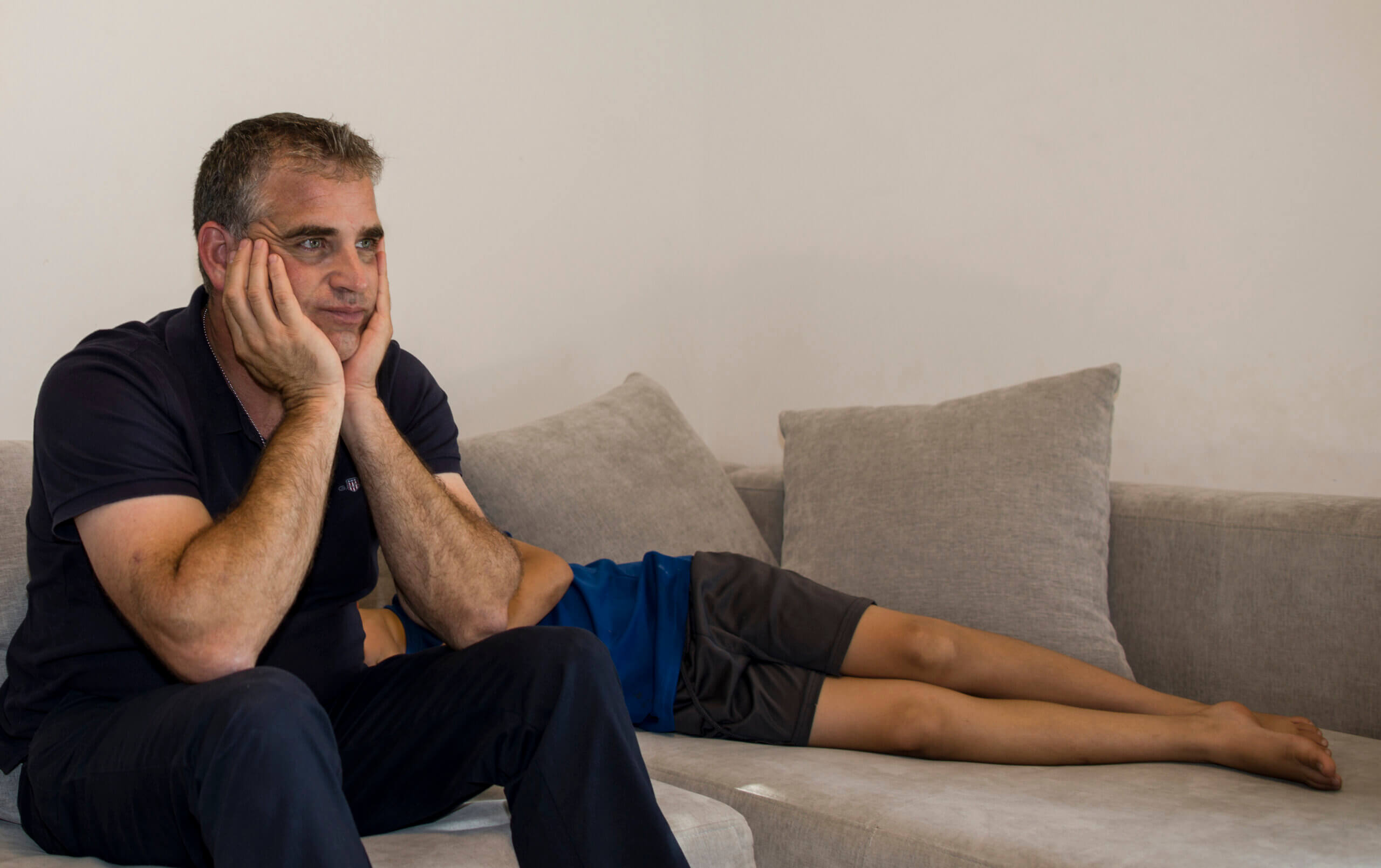
Itzik listened as the kibbutz security team, men he’d known his whole life, made a brave but ultimately hopeless last stand just outside the safe room. His own home was engulfed in flames during the battle, and Itzik emerged to scenes of unimaginable destruction: Only six Nir Oz homes were undamaged.
Now, the boy who could not resist the pull of his kibbutz is rallying his surviving neighbors to rebuild elsewhere. When Itzik thinks of going back to live on Nir Oz, he imagines walking on pathways stained with blood, the eyes of murdered friends staring back at him. Instead, he has brokered a deal for dozens of families to move together to this quiet kibbutz about an hour away from Gaza.
“I believe, with all my heart, that we can return to be normal people,” he told me. “We have to open a new life.”
But Israel’s plan to rebuild is focused on returning residents to the Gaza border region, so Itzik’s group has been trying to fundraise $25 million for the move together to a new location, a plan that relies on American Jewish donors who have so far been wary of funding an unconventional project that some other Nir Oz residents have denounced as a betrayal.
Over two weeks in September, I spent hours talking to residents in both groups — visiting their temporary apartments in Kiryat Gat, an industrial city about 30 miles from Nir Oz; touring the empty land at Kibbutz Beit Nir, where many would like to move; and walking the devastated remains of Nir Oz.
They shared everything that has happened since Oct. 7, and how the lack of certainty about what comes next has made it hard to imagine a future beyond the wreckage of Israel’s deadliest day.
Billions of shekels — for those who return
After the Hamas attack, the Israeli military evacuated the 50,000 people living within 2.5 miles of the Gaza border, paying nearly $250 million to support their extended stays in hotels, and later apartment complexes, farther from the fighting.
In March, Israel’s government announced that housing subsidies for 18 border communities — not Nir Oz and others that were especially hard-hit — would end in July, and offered cash incentives for residents willing to return sooner. The next month, the cabinet unveiled a $5 billion, five-year plan to rebuild the region.
A year after the attack, officials estimate that almost 90% of the Gaza-area evacuees have returned to their homes. The rest are scattered — some, like the 125 households from Nir Oz in Kiryat Gat, trying to retain the closeness of their communities; others starting new chapters in new places.
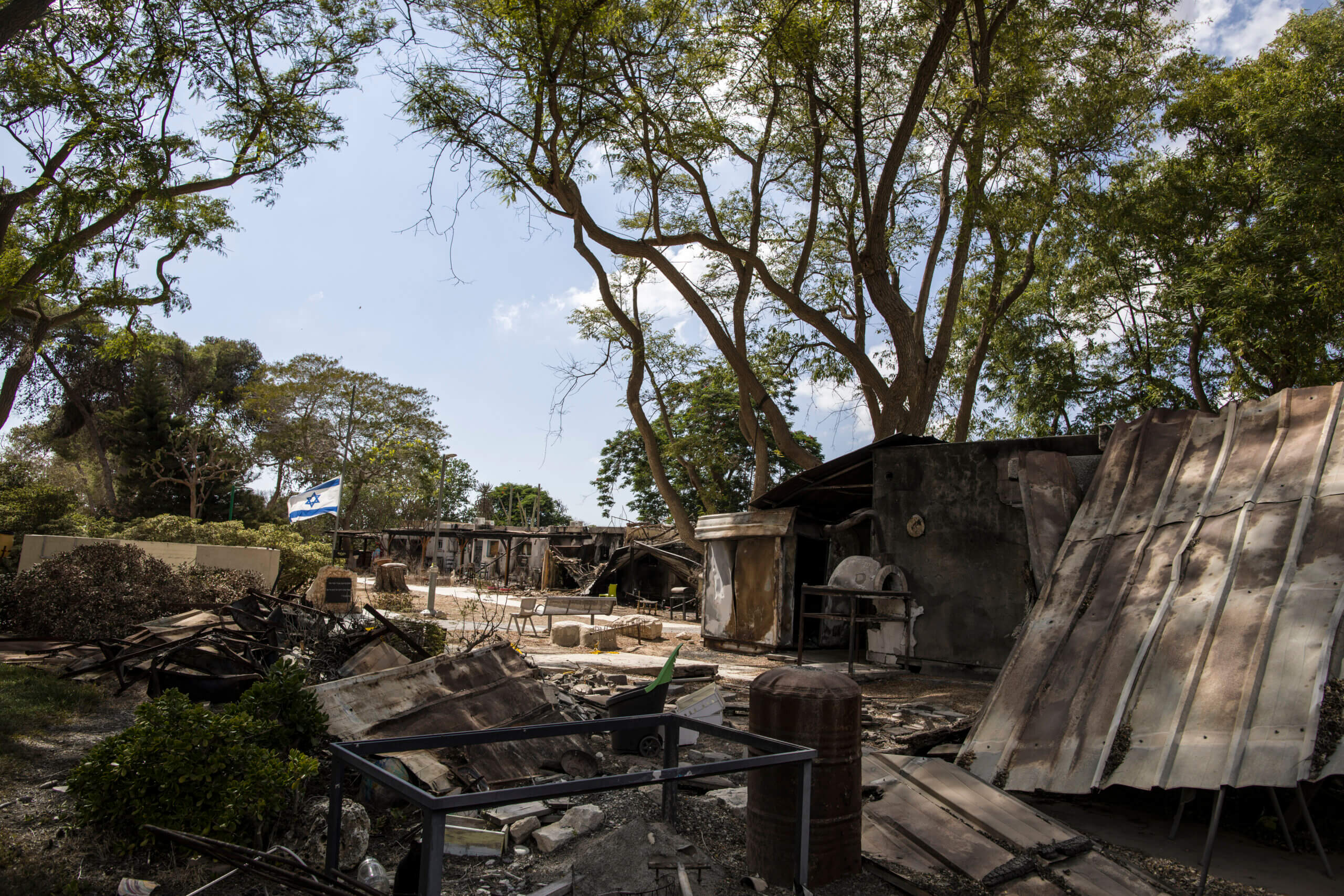
Nir Oz is one of eight kibbutzim requiring so much repair that the government plans to pay for residents’ housing for at least another year. After that, it’s either return to live at the site of a horrible massacre, or finance the future on your own.
Neither choice is acceptable for some survivors, who insist that they cannot return to their old homes — nor forfeit the comfort of friends and family who experienced the same trauma.
“I’ll sit here and cry, and it’s fine,” said Ophir Yechayes, 29, one of the Nir Oz residents nestled in a small neighborhood of apartment buildings in Kiryat Gat. “Here I don’t need to say nothing, and everybody understands.”
Her family is one of 54 — some 60% of Nir Oz survivors — that have signaled their intent to resettle in Beit Nir. But that plan has exposed a fault line between those who see Nir Oz as a physical place and those who think of it as an extended family that can flourish anywhere.
The Israeli government has prioritized moving people back to the otef, a Hebrew word that means “wrapper” or “envelope,” and refers to the borderlands near Gaza. Rebuilding communities there is considered important for politics and security, and to show the country’s resilience. It also avoids setting a precedent of subsidizing relocation not just for the Gaza-area survivors of Oct. 7 but for tens of thousands of other Israelis who have left communities near Israel’s border with Lebanon because of rocket fire from Hezbollah.
That larger universe of people potentially needing resettlement is also daunting for American donors.
“Private philanthropy doesn’t have the ability to help every person who wants to relocate away from the otef,” said Stephen Hoffman, chair of the Mandel Foundation, who has also helped distribute funds raised by the Jewish Federations of North America. “Helping people at that scale is, in conventional thinking, a government responsibility.”
The Israeli government says it has taken charge of the situation — creating a special agency, called Tekuma, to handle rebuilding — but remains focused on returning former residents to their old homes, not helping them leave. (Tekuma is Hebrew for “revival.”) This has created one of several gulfs between state officials and some survivors of Oct. 7, and made U.S. donors wary of supporting what could be characterized as open revolt against the government’s handling of the attack and its aftermath.
“We were the border. And we cannot do it anymore.”Neomit Dekel-ChenNir Oz resident
Meanwhile, at Nir Oz, the few buildings not destroyed in the attack stand empty. Wild parakeets soar around the kibbutz, while stray cats and dogs — some from Gaza — pick their way through shards of windows and dishes from modest homes that were consumed by flames.
In the sterile confines of Kiryat Gat apartments, the people who made it out alive run into each other on the elevator or while dropping children at a kindergarten hastily constructed next to a dusty roundabout. They miss the big front porches and open fields of Nir Oz, and the lack of certainty about what will come next is taking a toll.
Itzik, who is leading the charge to rebuild in Beit Nir, acknowledges that such a move would be years away, even if the government or private donors were to immediately pony up the additional $25 million he believes is needed. Meanwhile, the elected leadership of Nir Oz controls income from the kibbutz’s ongoing businesses as well as any grants from the government and some private donations, and generally supports the minority of families that want to return to the kibbutz.
And at least 16 Nir Oz residents, along with a Thai farmworker from the kibbutz, are believed to be among the 100 remaining hostages in Gaza, though no one knows how many are alive.
Itzik, whose natural charm helped him excel at selling potatoes, is a man of winks and jokes, who usually avoids dwelling on the most emotional aspects of his community’s devastation. One afternoon as he sat in his temporary apartment with his teenage son, though, he dropped the mask.
“Anachnu b’azazel,” he said in Hebrew. “We’re in hell.”
The forgotten kibbutz
Itzik, his wife and their three kids had Shabbat dinner on Oct. 6 with Itzik’s father, Aryeh, 70, the kibbutz ambulance driver and a veteran of the Yom Kippur War, which had broken out exactly 50 years earlier. After dinner, Aryeh headed back home on a motorized scooter and announced that he was going to sleep in his safe room, saying, “And then the war can start.”
He still isn’t sure why he made that prescient comment. But his phone started buzzing shortly after 6:30 a.m. with pleas from injured residents: “I need help, I need help, I need help, come to me, come to me.”
He jumped out of bed, dressed in his uniform, and called Shachar Butler, who ran Nir Oz’s volunteer security team, to say that he was going to pick up a couple who had been shot during their early morning walk.
“Run back to your room,” Butler told him. “Don’t come out.”
More than 100 members of an elite Hamas unit called Nukba had already breached the two yellow gates that protected the main road into the kibbutz as well as the smaller “grape gate” that leads to a vineyard facing the Gaza border.
The terrorists had blown a hole in the fence outside Butler’s house, and pinned down another member of the security team. A handful of volunteers with rifles could not mount serious resistance, and the infiltrators began a chaotic reign of terror, including blowing up the kibbutz ambulance. Two members of the security crew were killed near the center of the community after engaging the intruders in a doomed firefight.
As the elder Itzik retreated to his safe room, he left the front door to his house unlocked, hoping to signal to the terrorists that it was empty. The gambit worked: Hamas used his home as a base of operations, apparently never noticing the elderly man hiding under a blanket even as they looted a television from right above his head.
Nearly everyone else in that section of Nir Oz was killed or kidnapped.
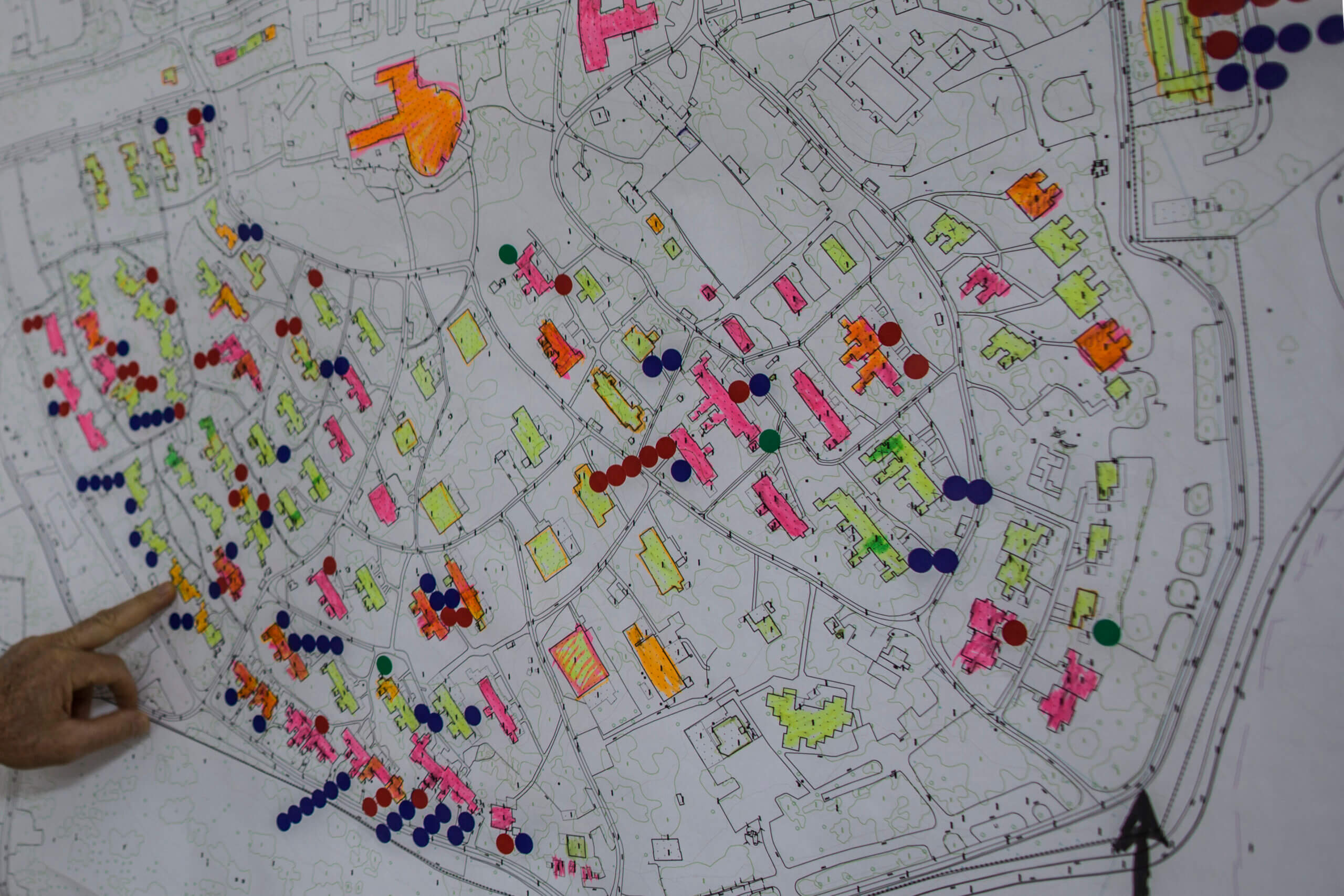
The kibbutz was the only one of 19 Hamas attacked that day that endured major violence with no response from the Israeli army. Despite desperate reports from residents trapped inside, the Israel Defense Forces did not acknowledge the attack on Nir Oz until two hours after it began. Soldiers dispatched to help were diverted en route.
Residents survived by holding onto their safe room door handles as the militants tried first pulling and banging, then sweet-talking them in perfect Hebrew: “Hey, open, open, it’s OK.” Barak Morag huddled in a locked safe room with his wife and two children as it slowly filled with smoke; down a short path, his father- and brother-in-law, David and Tal Shalev, were killed after a rocket-propelled grenade punched a hole the size of a basketball in their shelter door.
Militants shot Tamar and Jonny Simantov through their safe room door, then lit the house on fire, suffocating the couple’s 5-year-old twin daughters, Shahar and Arbel, and 2-year-old son, Omer.
Ron Bahat tied a rope around his safe room door handle and held it tight. Hamas men gave up trying to get in and instead cut the chain to his motorcycle with tools from his shed and hauled everything back to Gaza.
“It’s like if you take a kid to a toy shop and tell him everything is free,” Bahat said of the rampage through the kibbutz.
Terrorists kidnapped the Bibas family, including baby Kfir, after gorging themselves on leftover steak and Coca-Cola at the Yechayes’ house next door while Ophir and her family cowered in their safe room. “Our luck is that we had good food,” she told me with a grim laugh.
Border police finally arrived more than an hour after all the militants and looters had left.
“Commanders simply forgot about Nir Oz," a senior IDF officer told Haaretz.
The next morning, soldiers dispatched Aryeh Itzik and a few other residents to collect the bodies.
More people had been killed at Kibbutz Be’eri and Kfar Aza, but they also had much larger populations; roughly 30% of Nir Oz was missing or dead. About half the homes in both Be’eri and Kfar Aza escaped Oct. 7 without damage. In Nir Oz, only six were spared gun shots, explosions and arson.
Later that afternoon, the army ordered residents onto buses for Eilat with only what they could carry. Itzik, the nurse-turned-ambulance driver, barely had time to change his blood-soaked shoes.
At the hotel of broken dreams
Galit Bareket worked as community manager at Nir Oz for six years until 2022, though she lives here on Beit Nir, the kibbutz where Itzik and many of the other survivors now want to move. So on Oct. 7 she was in her home on the community’s edge, with views all the way to the Mediterranean, watching on television as Nir Oz burned.
When she learned the next day that her former employers and old friends had evacuated to the Yam Suf Hotel in Eilat, Bareket headed south, arriving a few hours after the buses from Nir Oz. The first person she saw was Nir Metzger, a former chairman of the kibbutz, whose parents had both been kidnapped.
“He just fell on the floor and he was screaming, ‘I don’t have a father and a mother,’” she recalled.
The scene was no better inside the hotel. Sigal Yehud, nine months pregnant, was holding onto her three young children; her husband, Dolev, had left them in the safe room the day before. “Please tell them to let me know what happened to him,” Yehud told Bareket. “I cannot live with this doubt.”
A week later, Sigal gave birth alone, to a daughter she named Dor because it starts with the same letter as Dolev. “She needs to know her father and she needs to grow up with her father,” she said in a TV interview at the time. Eight months later, her husband’s burned body was discovered underneath a collapsed awning on Chen Itzik’s porch.
Another woman at the Eilat hotel showed Bareket her hands, covered in blisters from gripping the metal handle of her safe room door for eight hours while her house burned. “How come we got out of it alive?” one man asked.

Rena Bazar, the kibbutz secretary, dragged a table into the middle of the lobby and sat writing lists in her notebook: Who was entering the hotel, who was leaving, which children had survived, who was missing, and all that she remembered from the day before.
Itzik was hallucinating, seeing the faces of friends who had been killed back at the kibbutz. He left the hotel on Oct. 11 to return to work running the agricultural cooperative for the Gaza-area kibbutzim, which produces around one-third of Israel’s potatoes and 40% of its carrots. He would come to Eilat on weekends, to what his neighbors had taken to calling the hotel of broken dreams.
“Everybody was sitting in the lobby like zombies all day,” he recalled. “Kids were out of order, swearing, fighting.”
Itzik enlisted a few others to help find transitional housing. They settled on a neighborhood of new high rises in Kiryat Gat, a working-class city of 60,000 that began in 1954 as an absorption center for Jewish refugees from Morocco. The Israeli government agreed to pay the rent for around 130 apartments, roughly $1,500 per month each, until the homes in Nir Oz are rebuilt.
The community voted nearly unanimously in favor of the move, and in January Nir Oz became the first group of evacuees to leave their hotel. Children made a banner that showed the destruction of Nir Oz, the move to Eilat and the apartment towers of Kiryat Gat, surrounded by question marks. Their drawings predicted a return to Nir Oz with a smiling sun.
But the adults were already divided over whether they could ever go back.
Living in paradise to serve the state
For decades, residents of Nir Oz and other Gaza-border communities saw themselves as serving the state. The first kibbutzim were built in the Negev shortly before Israel declared independence in 1948 to ensure that the area would be included in a future Jewish state. Nir Oz was established as a military outpost on the ruins of a Bedouin village in 1955 to close a gap between Nirim and Nir Yitzhak — two other communities attacked on Oct. 7 — that militants from Gaza were using to enter Israel.
The ensuing years were relatively placid at Nir Oz. Gazans worked in the fields outside the kibbutz and in its paint factory. They also built many of the houses that were destroyed in the attack, some joking — at least it felt like a joke back then — that they were really building them for their own families.
The situation worsened after Israel disengaged from Gaza, removing settlements and soldiers, in 2005. Hamas wrested control of the strip the following year in a bloody coup, and the volleys of rockets the group launched toward border communities led many young families to leave during the heaviest barrages.
But mostly they stayed.
Residents loved the quiet, rural, communal life on Nir Oz. And the state land around the kibbutz was basically free, which helped younger residents build new homes and become members.
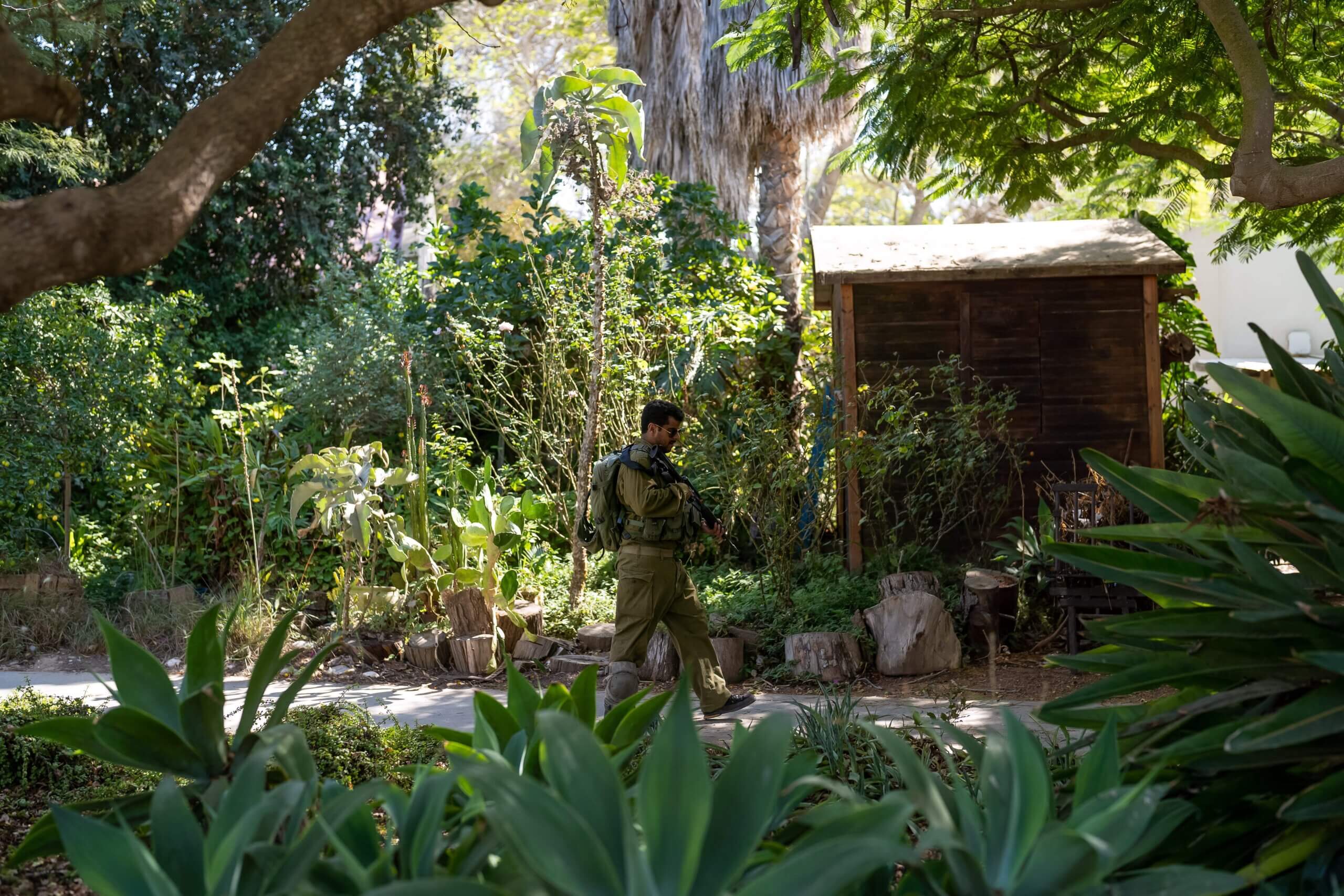
“It was 99% paradise and 1% hell,” Benny Avital, a member of the kibbutz security team, told the New York Post in December.
In 2008, after Nir Oz was forced to harvest its potatoes at night to avoid sniper fire from Gaza, one member said proudly, “This is Zionism.”
In 2013, Israeli soldiers discovered the entrance to a Hamas tunnel near the kibbutz. Some residents began keeping their lights off and curtains drawn at night until the army built a new high-tech border barrier that was supposed to be impenetrable. Five years later, as Israeli soldiers clashed with Gaza protesters rushing the barrier, children from Nir Oz played a few hundred meters away.
But Nir Oz residents, like those of other nearby kibbutzim, are largely liberal and have been thorns in the sides of Israel’s increasingly right-wing governments. One of the Nir Oz founders, Oded Lifshitz — who is still in Hamas captivity — is a retired journalist who helped expose the Sabra and Shatila massacre in Lebanon. In Nir Oz, 88% of residents voted for parties that are not part of Prime Minister Benjamin Netanyahu’s coalition.
Families of many of the hostages taken from Nir Oz have also been among the most vocal critics of Netanyahu during the war. Reuma Kedem, whose daughter and grandchildren were killed at Nir Oz, accosted Yoav Gallant, the defense minister, when he toured the kibbutz in January. “Rotten government,” she told him. “What are you doing?”
Netanyahu left Nir Oz off a map of border communities that he displayed during a news conference about the war last month, further alienating displaced residents.
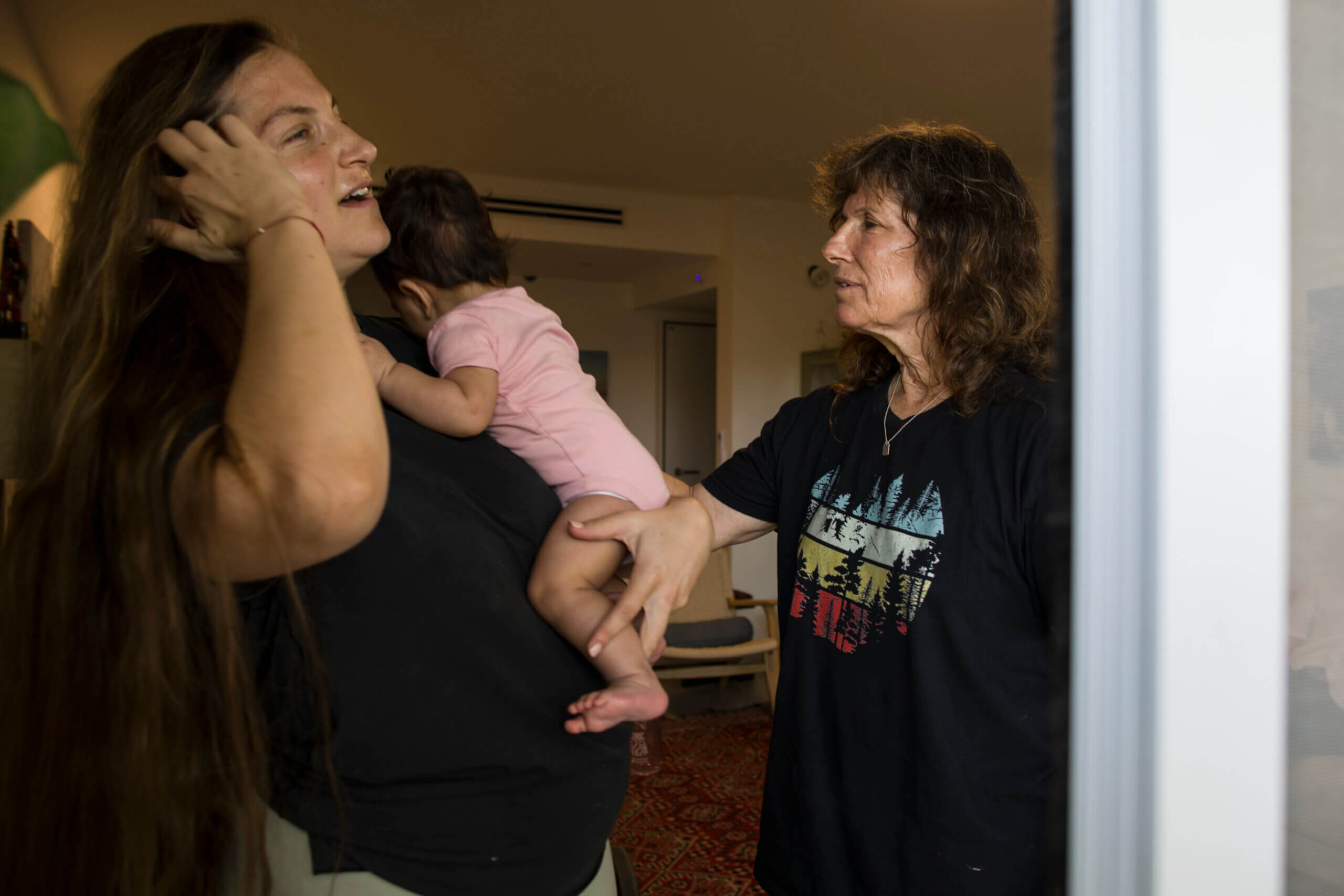
Neomit Dekel-Chen, who lived at Nir Oz for over 30 years and managed the grounds, told me that she never left during prior bouts of missiles and rockets. If she was too far from home to run to her safe room, she would lay down in the grass that she tended.
On Oct. 7, Dekel-Chen left her safe room when it filled with smoke. She was abducted by Hamas, but as they whisked her back to Gaza, an Israeli helicopter fired on the vehicle, killing her captors and one hostage. Dekel-Chen played dead, and was able to escape; her son Sagui, 35, a nonprofit worker with a penchant for converting buses into grocery stores and classrooms, remains in captivity.
Dekel-Chen and others see the government’s promises to add Wi-Fi and bulletproof doors to kibbutz safe rooms not as reassurances, but admissions that another attack is inevitable.
“We were the border,” she said. “And we cannot do it anymore.”
The drive to rebuild
But Nir Oz has a strong hold on many of its residents, especially those who have been there for decades.
Natan Bahat, 86, was unfazed by the alarms that blared across the kibbutz on the morning of Oct. 7. He only entered his safe room when he saw terrorists running past his house.
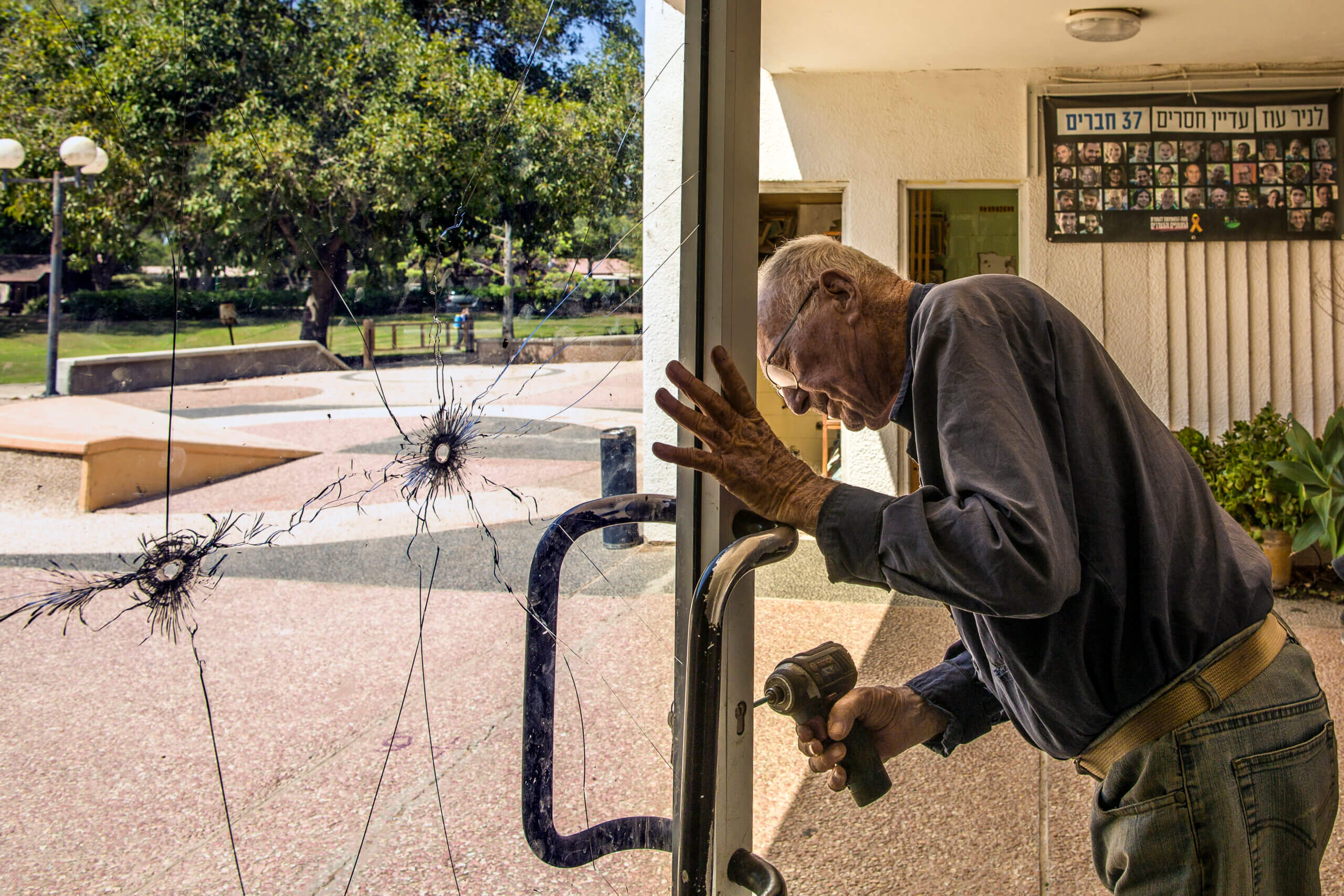
Bahat tried to return almost immediately after the attack, but his son Ron, who also lived at the kibbutz, would not allow it.
“Nobody is here,” Ron, who is 57, told him. “You don’t have a car, what if something happens and you have to leave?”
The elder Bahat bought a car. He has been back at the kibbutz since November, zipping around the grounds on a fleet of old motorized scooters that he repairs in a threadbare work shirt and tattered jeans.
An Israeli folk song from the Yom Kippur War in 1973, “The Wheat Still Grows,” has been stuck in his head:
It’s not the same old house now, it’s not the same old valley,
You’re gone and never can return again.
The path, the boulevard, a skyward eagle lingers…
And yet the wheat still grows again.
Bahat, whose wife died in 2022, eats lunch in a corner of the dining hall with a couple dozen farm workers and others who are keeping the kibbutz’s various businesses running. And his son is there almost every day, working at the operations center inside a bomb shelter at the center of the kibbutz.
Before Oct. 7, the younger Bahat managed the factory of an Israeli concrete company that manufactured many of the panels and guard towers along the barriers between Israel and the occupied West Bank and Gaza. He has not gone back to that job..
He also never made the move to Eilat, instead living with his wife and two of his teenage daughters in a town near Nir Oz, and spending his days mapping the damage to the kibbutz and thinking about how to rapidly rebuild it.
Unlike his father, Ron is not among the 100-some members of the kibbutz, who collectively own the community and can vote on its budget and policies. He only moved back to Nir Oz in 2021, after more than a decade in North Carolina. Like Chen Itzik, and more than half of the people who were living at the kibbutz on Oct. 7, he is considered a “renter,” despite deep ties to the community.
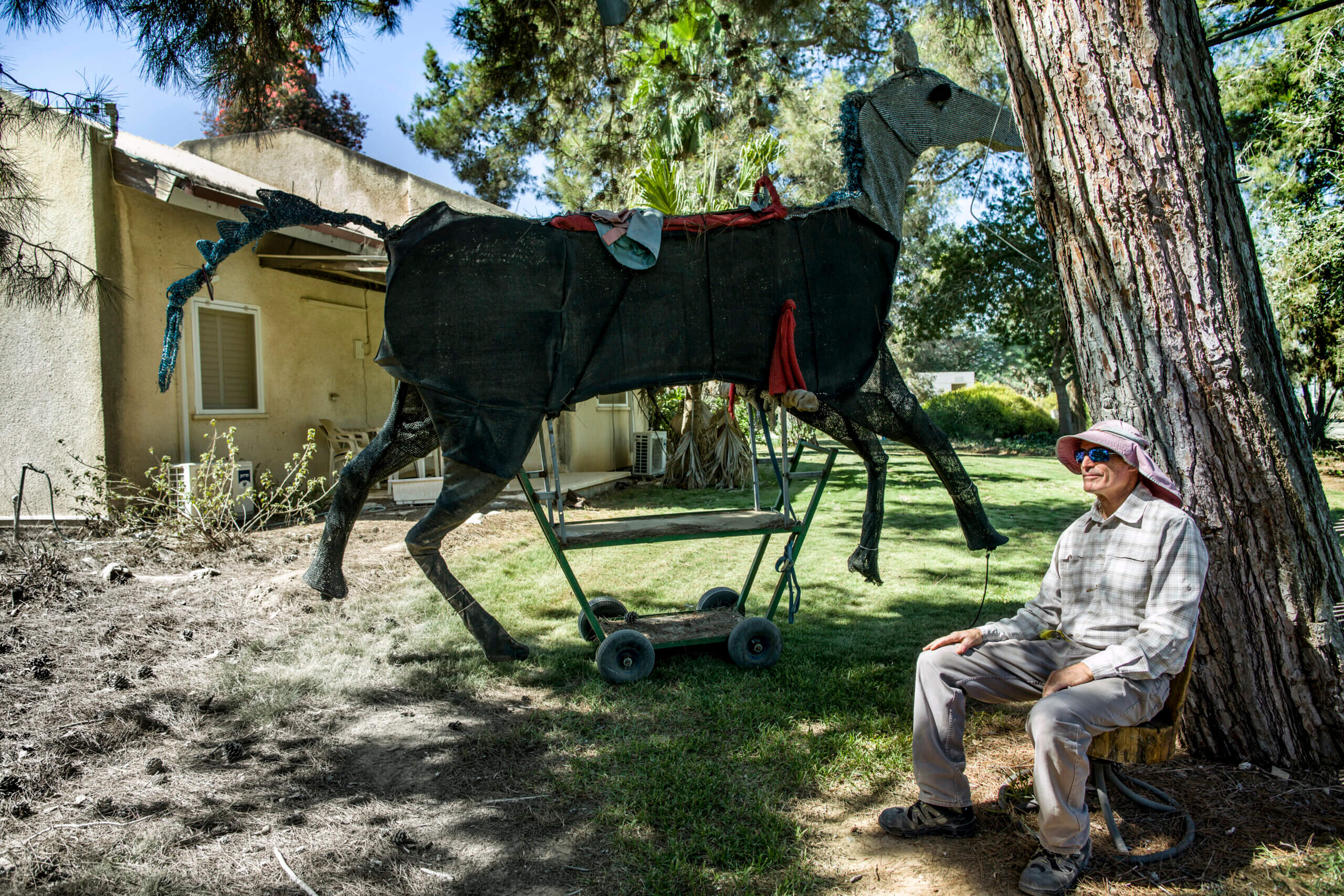
“I was thinking that someone from the kibbutz would show up and replace me,” Bahat said, referring to the members, who are mostly older. “But nobody came.”
Regardless of his official status, Ron Bahat has become a constant presence at Nir Oz, sipping on hot lemon water at his desk in the bomb shelter and donning a faded pink sun hat to guide visitors through the ruins. Haaretz called him “the sheriff, the mayor and the keeper of the abandoned kibbutz.”
The board of directors has hired him to manage the renovation, and Bahat came up with an ambitious plan that involves doubling the size of the kibbutz and expanding the size of its homes, building a huge sports complex and hiring the best teachers in Israel for an overhauled school system.
“The only win for us is to rebuild this place,” he said. "If this place will not be rebuilt that will show that we lose — and we cannot lose.”
Moving away from home, together
While Bahat was dreaming of a new and improved Nir Oz, Itzik became convinced that the families with young children would not bring them back to live along the border.
“They want to increase the size of the kibbutz?” Itzik said during one of our many conversations, barely able to contain his exasperation. “Who they will do it for? For new people!”
Even those who don’t want to go back to Nir Oz itself nonetheless long to re-create its way of life.
The kibbutz is home to more than 900 species of flora, many planted in the early years to create shade and prevent debilitating sandstorms. Cars were kept in parking lots on the periphery; inside, people mostly biked or walked. Until the membership voted to privatize in 2021, Nir Oz was one of the few kibbutzim in Israel to remain a true collective, in which members traded their salaries for food, housing, healthcare and a small stipend, even in retirement.
Barak Morag’s wife, Ziv, grew up on Nir Oz, and the couple moved back nine years ago, when they decided to have kids. Their house was tiny, around 300 square feet, with a cramped kitchen and living room. The kids’ room doubled as the bomb shelter.
When Morag gave a tour to some visitors from New Jersey recently, one asked if the family only used the house for sleeping. “I never thought about it,” he said. “But yes.”
School lasted until 4 p.m., and his family usually ate dinner outside with friends. Sometimes, the grown-ups would go back out after the children fell asleep, confident that they could make it back by bicycle in 30 seconds if they heard them crying.
“In a city, you can never have this,” Morag said.
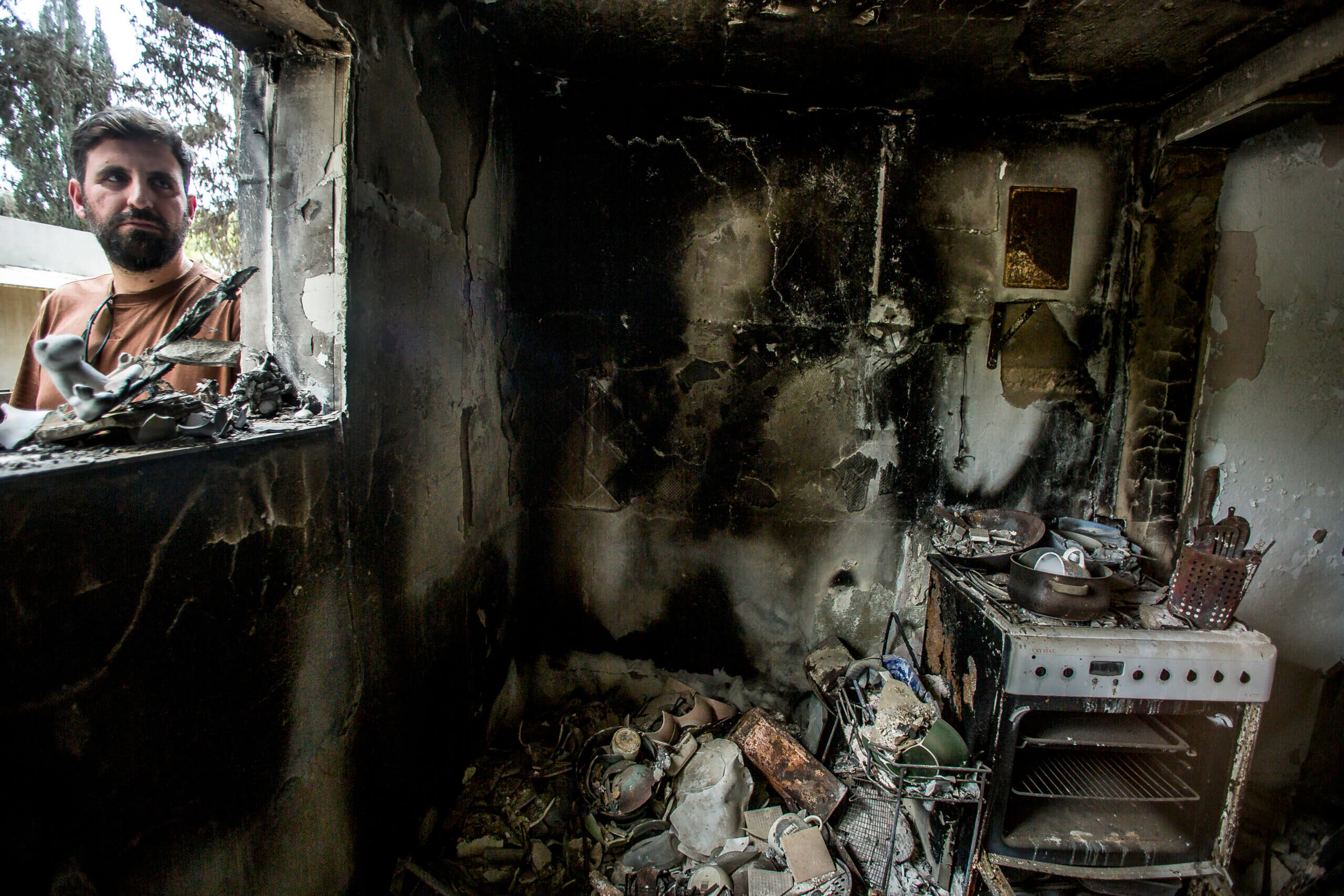
Before Oct. 7, Nir Oz was in the midst of modernizing. A large supermarket opened last year and a new kitchen was installed in the dining hall a few weeks before the attack. Both were destroyed. The kibbutz was also upgrading its roads and utilities, and, crucially, the recent privatization meant that members could join without forfeiting their financial independence.
Bareket, the former community manager, said the timing of the attack felt particularly devastating because the kibbutz had just finished making changes residents believed would guarantee its future.
“We had a dream,” she said. “This dream just snapped.”Nir Oz was preparing to welcome 40 new members in November 2023, many of whom had grown up on the kibbutz, and had returned with their own young kids to rent homes there. They planned to build on new plots cleared at the edge of the kibbutz. Morag, for one, had picked out a spot near many of his friends. “All of the friends that are not here,” he sighed.
After the attack, Morag and many others who survived were determined not to scatter to Beer Sheva, Ashdod or Tel Aviv.
“We really need each other to actually just get up in the morning,” said Mor Tzafarti, 42, who works as a counselor for young adults from the kibbutz. She had planned to build a house near the Morag family. “It sounds dramatic, but this is how it is.”
Over these many months in Kiryat Gat, Tzafarti has regularly watched the children of friends and brought them food when they’re having a hard day.
“We were very connected before,” she explained. “Now it’s like we’re glued to each other.”
Scramble for funding
Around December, Itzik started organizing the families that didn’t want to return. They toured 12 kibbutzim in the Negev before honing in on Beit Nir, a community of about 600 located on the remains of an Arab village in the foothills of the Judean Mountains. It’s an 18-minute drive from Kiryat Gat.
About five miles from the West Bank, Beit Nir is elevated above the desert plains, and you can see the skyline of coastal Ashkelon on clear days. Shepherds from the kibbutz contend with hyenas that prowl the nearby mountains.
Beit Nir was established in the same year as Nir Oz, 1955. Bareket, who has lived on Beit Nir for years, while helping to manage other kibbutzim, served as something of a bridge between the two communities; a number of people from Nir Oz also have friends on Beit Nir from the army.
Like Nir Oz, Beit Nir had been planning an expansion. There are more than 60 plots available, and the kibbutz agreed in principle this spring that it would accept refugees from Nir Oz without subjecting them to the complex approval process often involved for a new family to join a kibbutz.
The only obstacle was money.
Most of the land in Israel is owned by the government or the quasi-governmental Jewish Agency for Israel, and leased to its occupants in 99-year increments. When kibbutzim want to build new homes, they have to lease more land from the government.
The Israeli land authority was willing to essentially give away new plots in Nir Oz because of its proximity to Gaza, so the families that were preparing to build new homes there had only budgeted for construction costs. But the government set the price for the Beit Nir plots at $25 million. Itzik budgeted another $31 million for construction and membership fees at the new kibbutz, and in January sent a letter to Tekuma on behalf of 41 Nir Oz households, asking that the recovery agency help them build in Beit Nir.
We “chose as a Zionist act to live in Israel’s border region,” the letter says. And “contrary to the promises of the state of Israel, and in violation of the basic agreement between a citizen and his state, a terrible massacre took place.”
Itzik said that Tekuma’s director at the time, a retired general named Moshe Edri, essentially said no: “The directive they got was to rebuild the kibbutzim, not to deal with people who are not going back.”
A Tekuma spokesperson told me the government was considering creating a separate process to support families who want to relocate.
Itzik, meanwhile, has crafted a scheme to lower the cost. Children of kibbutz members usually get a two-thirds discount on new housing plots in their community. So the Nir Oz families are lobbying the housing authority to let them get that discount at Beit Nir, which would bring the total relocation cost down to around $38 million. The families themselves, many who had been saving for years, plan to cover $14 million of it.
(The Nir Oz leadership, who did not answer my questions by email, has rejected the breakaway group’s request to support this scheme, according to Itzik.)
The idea would be to raise the remaining $25 million through philanthropy. After all, Jews around the world donated more than $1.4 billion in the wake of the Oct. 7 attacks, to bridge gaps between government aid and survivors’ needs. But a lot of that money is still sitting in American bank accounts.
The Jewish Federations of North America, an umbrella group, has $36 million at its disposal, while individual federations have a total of about $274 million, according to a Forward analysis, including roughly $70 million at the New York federation alone.
The Israeli government helped the families who want to move to Beit Nir become a nonprofit so they could accept donations. The group created a business plan, and with Eretz Nehederet, the famous Israeli sketch-comedy show, made an emotional 17-minute film appealing for funds.
“We cannot pick up the ruins of our lives and rebuild our homes above the gates of hell,” the film’s narrator says. “We are asking for the opportunity to rebuild our community somewhere quieter.”
This summer, Itzik and a handful of other Nir Oz residents spent a few weeks in the U.S., meeting with officials from foundations belonging to Bernie Marcus, Paul Singer, David Zalik, Haim Saban and the Mandel family, as well as the New York and Atlanta federations. All were sympathetic, Itzik said, but reluctant to commit; many seemed to want someone else — especially JFNA — to make the first move.
Itzik has so far managed to raise $1.5 million, mostly consisting of a pledge of $1 million from Temple B’nai Jeshurun, a Reform synagogue in Short Hills, New Jersey, which also brought b’nai mitzvah-age kids from the kibbutz to the U.S. in June. He is not sure how to shake more money loose.
“It’s a kind of dance that I don’t really understand,” he told me. “I don’t speak American.”
Running out of time
UJA-Federation of New York has given $1 million to Nir Oz’s recovery efforts, but declined to say what that money was for. American Friends of Nir Oz, which launched Monday and has yet to raise any funds, is also trying to stay away from the community's internal divisions said Abbey Greenberg-Onn, a board member. The Marcus and Zalik foundations did not respond to inquiries, and the Jewish Federations of North America would not make anyone available for an interview.
“The residents of Kibbutz Nir Oz, like all Israelis affected by the war, are near and dear to Jewish federations,” a JFNA spokesperson said in a brief email.
Hoffman, who is co-chairing the federation network’s allocation process, said it is still considering the request. “The door hasn’t been closed,” he said.
Ron Bahat, leader of the group that wants to rebuild at Nir Oz, also made a fundraising trip to the U.S. earlier this year, seeking $150 million for a new and improved kibbutz.
“Nir Oz is here,” he told me as we sat in the operations center one day last month. “Nir Oz is going to be rebuilt here.”
Bahat showed me around the refilled pool, and said that several families who recently came for a swim asked him not to take photos for fear they’d be harassed by friends in Kiryat Gat for returning to the kibbutz. The kibbutz is also divided over how to memorialize the attack, with the families of some victims insisting that the burned house should be left standing.
“They want to keep this place miserable,” Bahat said of Itzik and other leaders of the Beit Nir plan.
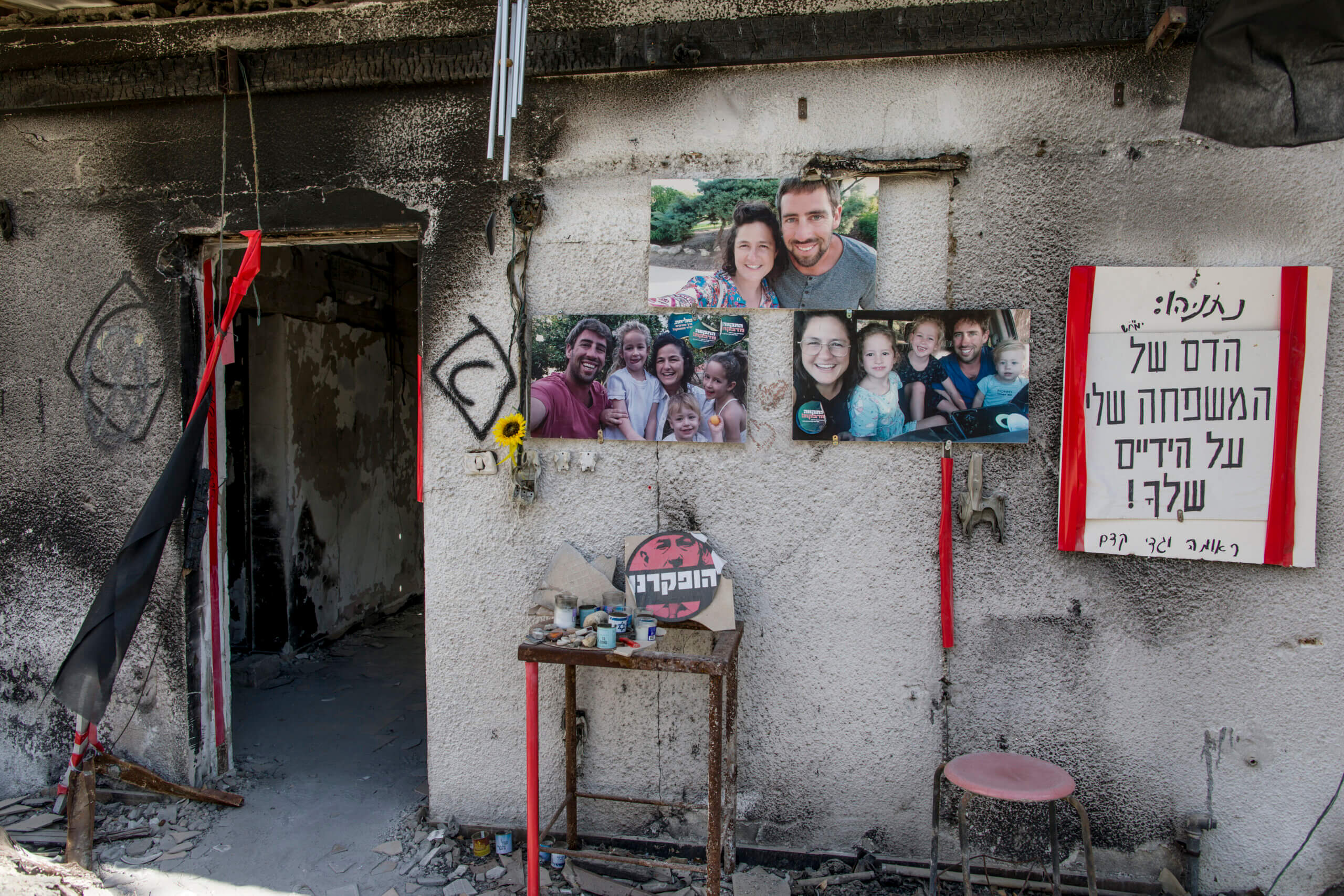
The Chicago Jewish federation has committed $5 million to Nir Oz, with the money so far split between services to former residents in Kiryat Gat and improvements at the kibbutz itself. “The people, as people, are worthy of our support,” said Ofer Bavly, head of the federation’s office in Israel. “But if somebody says they want to go live in Tel Aviv, or for that matter New York, obviously we’re not going to give them money to relocate.”
Itzik’s group does not want to move to Tel Aviv or New York; they want to keep living on a kibbutz in the Negev — just not the one where their friends were killed and kidnapped.
Most of the families had saved money to build at Nir Oz, picked out plots and were slated to become members in November. Those plans were upended by the Hamas attack. The same house someone had planned to build in Nir Oz for $400,000 will now cost $800,000 at Beit Nir — and that’s the gap the families are trying to close with their fundraising.
“We have a solution so that people will not have to return to these horrible, bloody streets,” Itzik said. “Ron is trying to make it so that these people will not have any other choice.”
Others say there is plenty of money to go around. They note that the American foundations Itzik met with have not said no, and it is still possible that the Israeli government will support relocation to Beit Nir.
The Nir Oz families might also benefit from teaming up with residents of other kibbutzim who don’t want to return, presenting American philanthropists with a united front — and a higher dollar figure.
But for now, these survivors of Oct. 7 are caught in limbo.
“If, in a few months from now, people will not see a future then it will be hard,” Itzik said. “We are working — we’re not stopping — but we need the money.”
A life no one chose
Nir Oz is compact and green. Carmei Gat, the neighborhood of Kiryat Gat where the former residents are living, is sprawling and gray. It was built six years ago, and the landscaping remains unfinished; garbage gathers in the gutters.
The families from Nir Oz are quick to acknowledge that they live in huge apartments filled with donated furniture and TVs. “It’s more beautiful than I could imagine,” Aryeh Itzik told me. “We are refugees and we’re treated luxuriously.”
But they long for the stroll under a thick tree canopy to a dining hall whose lawn was manicured to look like a shining sun. Instead of greeting neighbors from his front porch, Aryeh takes the elevator to a community room for coffee with other seniors most mornings.
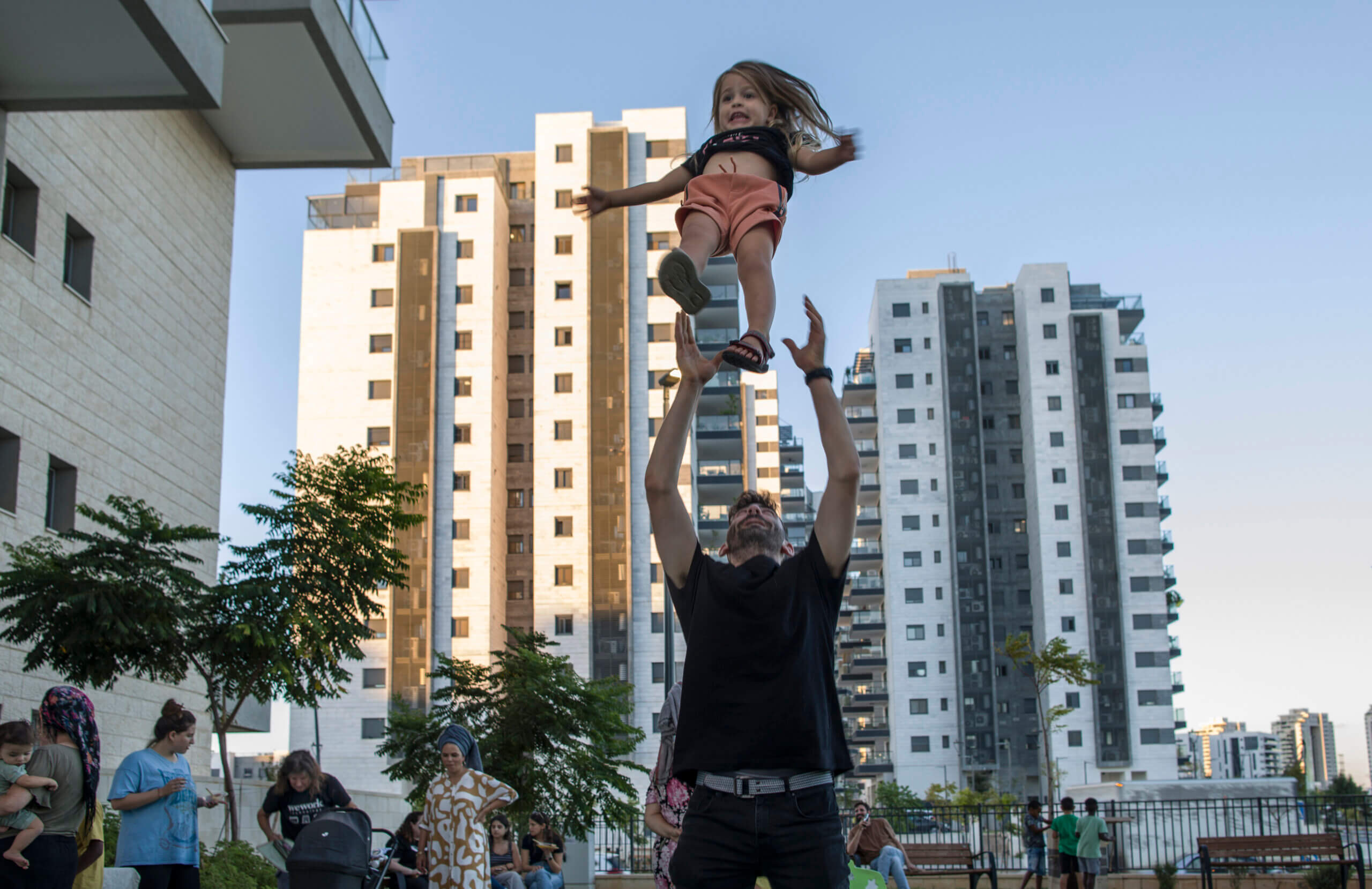
Dekel-Chen, 64, who escaped her kidnappers on Oct. 7, won’t go to the morning coffees — “I belong there by my age, but not by my feeling,” she said. Instead, she braves the busy roundabout to take her grandchildren to kindergarten each day. It’s what gets her out of bed in the morning.
She keeps a small greenhouse outside her ground-floor apartment, incubating plants for a few neighbors, and tends to a vine salvaged from the ruins of a Nir Oz home where the family was killed.
“I almost don’t go out of the house because of what happened to me,” she said. “I’m frightened all the time.”
Metzger, the former kibbutz chairman whose father was killed in Gaza after his mother was released in November, said that his 14-year-old son and 18-year-old daughter want to return to live in Nir Oz regardless of what their parents decide. Tzafarti, the woman who counsels young adults, said her own sons, ages 8, 11 and 12, are struggling because they aren’t used to being stuck inside. The middle one lost his temper a few days before I visited.
“He started yelling at me that he needs grass and he needs outside and he needs open spaces,” she recounted. “He wants to go back to Nir Oz. I told him sababa — not going to happen.”
But she doesn’t know what else to tell him. As much as she loves Nir Oz, returning there feels impossible. Beit Nir is on the horizon, but doesn’t feel real either. She just wants to know what comes next.
“No one chose this place,” she said. “No one chose this life.”
